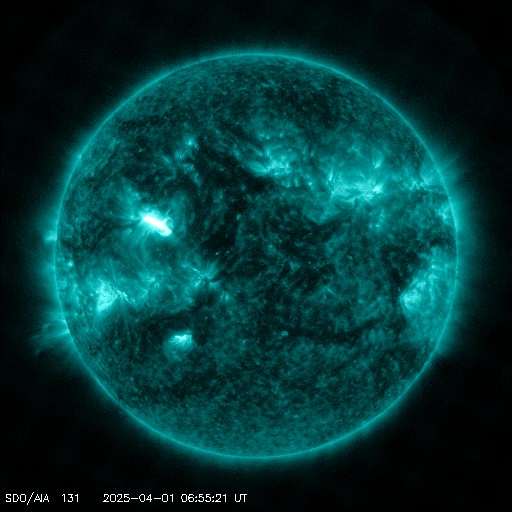Viewing archive of Monday, 10 June 2024
Geophysical report
Solar and Geophysical Activity Summary 2024 Jun 10 0245 UTCPrepared by the NOAA © SWPC and processed by SpaceWeatherLive.com
Joint USAF/NOAA Solar and Geophysical Activity Summary
SGAS Number 162 Issued at 0245Z on 10 Jun 2024 This report is compiled from data received at SWO on 09 JunA. Energetic Events
Begin Max End Rgn Loc Xray Op 245MHz 10cm Sweep 0359 0359 0359 330 0649 0701 0716 3697 S15W80 M1.6 Sf 110 0802 0819 0832 3709 M1.2 1552 1558 1602 3697 C3.2 110 1950 2017 2029 3697 M1.0
B. Proton Events
The greater than 10 MeV proton flux exceeded 10
pfu through 09/2135 UTC.
C. Geomagnetic Activity Summary
The geomagnetic field was quiet.
D. Stratwarm
Not available
E. Daily Indices: (real-time preliminary/estimated values)
10 cm 181 SSN 148 Afr/Ap 006/005 X-ray Background C1.9 Daily Proton Fluence (flux accumulation over 24 hrs) GT 1 MeV 7.2e+07 GT 10 MeV 2.6e+06 p/(cm2-ster-day) (GOES-18 satellite synchronous orbit W137 degrees) Daily Electron Fluence GT 2 MeV 1.20e+06 e/(cm2-ster-day) (GOES-16 satellite synchronous orbit W75 degrees) 3 Hour K-indices Boulder 2 1 2 1 1 3 1 1 Planetary 2 1 1 1 2 2 2 1
F. Comments
None.
All times in UTC
Current data suggests there is a slight possibility for aurora to appear at the following high latitude regions in the near future
Whitehorse, YT, Yellowknife, NTFairbanks, AK
Latest news
Latest forum messages
Growth of Cycle 25 822Similar AR 3664 vs AR 4048 ??? 7AR4046 143AR4048 60Temporary Topic - Ongoing Solar Proton Events 5
More topicsSupport SpaceWeatherLive.com!
A lot of people come to SpaceWeatherLive to follow the Sun's activity or if there is aurora to be seen, but with more traffic comes higher server costs. Consider a donation if you enjoy SpaceWeatherLive so we can keep the website online!

Latest alerts
07:15 UTC - 10cm Radio Burst
Begin Time: 01/04/2025 06:45 UTC Maximum Time: 01/04/2025 06:45 UTC Duration: 1 minutes. Peak flux: 190 sfu
07:06 UTC - Solar flare
Strong M5.61 flare
06:48 UTC - Radio Blackout
Moderate R2 radio blackout in progress (≥M5 - current: M5.36)
06:45 UTC - Radio Blackout
Minor R1 radio blackout in progress (≥M1 - current: M1.7)
02:15 UTC - Solar protons
Moderate S2 Solar Radiation Storm - Infrequent effects on HF radio through polar regions and satellite operations
Space weather facts
| Last X-flare | 2025/03/28 | X1.1 |
| Last M-flare | 2025/04/01 | M5.6 |
| Last geomagnetic storm | 2025/03/27 | Kp5 (G1) |
| Spotless days | |
|---|---|
| Last spotless day | 2022/06/08 |
| Monthly mean Sunspot Number | |
|---|---|
| February 2025 | 154.6 +17.6 |
| Last 30 days | 128.5 -22.7 |



